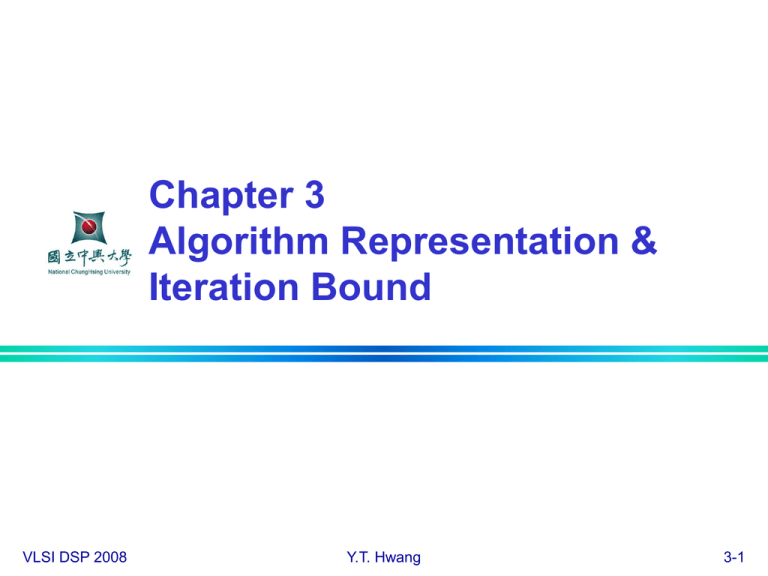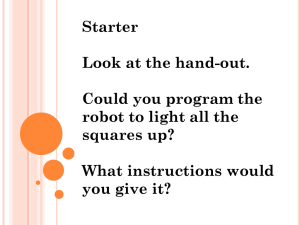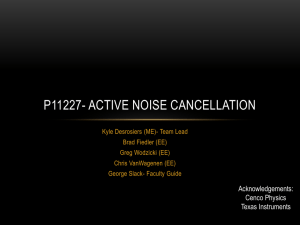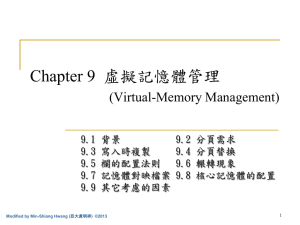Chapter 2 Digital Signal Processing Algorithms
advertisement

Chapter 3 Algorithm Representation & Iteration Bound VLSI DSP 2008 Y.T. Hwang 3-1 Representations of DSP Algorithms Mathematical formulations Behavioral description languages Applicative language Represents a set of equations satisfied by the variables, e.g. Silage Perspective language Explicitly specify the order of assignment, e.g. C and other HLLs Descriptive language Represents the structure of a DSP system, e.g. VHDL, Verilog Graphical representations Block diagrams Signal flow graph (SFG) Data flow graph (DFG) Dependence graph (DG) VLSI DSP 2008 Y.T. Hwang 3-2 Block Diagrams (1) Consists of functional blocks connected with directed edges Functional block, e.g. Add, Mult Unit delay element Directed edge representing the data flow between blocks Basic blocks VLSI DSP 2008 Y.T. Hwang 3-3 Block Diagrams (2) 3-tap FIR example Alternative block diagram with data broadcast VLSI DSP 2008 Y.T. Hwang 3-4 Signal Flow Graph (1) A collection of nodes and directed edges Node: computation or task Directed edge (j,k) a linear transformation from node j to node k Usually as constant gain multiplier or delay elements Widely used in digital filter structures Flow graph reversal (transposition) A transform to obtain equivalent structure Applicable to single-input single output system Reverse the directions of all edges Exchange the input output node Retain the edge gain and edge delay VLSI DSP 2008 Y.T. Hwang 3-5 Signal Flow Graph (2) SFG of a 3-tap FIR filter Original SFG Transposed SFG VLSI DSP 2008 Y.T. Hwang 3-6 Signal Flow Graph (3) Limitations of transposition can be applied to MIMO systems described by symmetric transform matrices More on SFG Applicable to linear network Cannot be used to described multi-rate system VLSI DSP 2008 Y.T. Hwang 3-7 Data Flow Graph (1) DFG Node: computation (function or subtask) Directed edge: data path or communication between nodes Associated edge delay: non-negative Associated node delay: execution time of each node add mpy Block diagram VLSI DSP 2008 Conventional DFG Y.T. Hwang Synchronous DFG 3-8 Data Flow Graph (2) Applications: high level synthesis Firing rules A node can fire whenever all the input data are available Concurrency: multiple nodes can be fired simultaneously Data driven (implicit) scheduling Precedence constraint Intra-iteration: imposed by edge with no delay Inter-iteration: imposed by edge with delay fine-grain (atomic) v.s. coarse grain DFG VLSI DSP 2008 Y.T. Hwang 3-9 Data Flow Graph (3) 3-tap FIR filter example Direct form Transpose form VLSI DSP 2008 Y.T. Hwang 3-10 Data Flow Graph (4) Synchronous DFG Number of data samples produced or consumed by each node is specified a priori Single rate system Multi-rate system: different nodes working on different frequencies Multi-rate system can be represented by a single rate system via unfolding (unrolling) VLSI DSP 2008 Y.T. Hwang 3-11 Introduction to Iteration bound DSP algorithms often contain feedback loops Impose an inherent lower bound on the achievable iteration or sample period Iteration bound Impossible to achieve an iteration period less than the iteration bound even with infinite HW t Iteration k-1 Iteration k Iteration k+1 Iteration k+2 Iteration period VLSI DSP 2008 Y.T. Hwang 4-12 Data Flow Graph Representations For n = 0 to ∞ y(n) = ay(n-1) + x(n) Intraiteration Execution time of a node Critical path AB Interiteration Iteration – execution of each DFG node once Precedence constraints Intra-iteration – no delay on edge Inter-iteration – at least one delay on edge VLSI DSP 2008 Y.T. Hwang 4-13 Critical Path Critical path of a DFG The path with the longest computation time among all paths containing zero delays The minimum computation time for one iteration of the DFG 6→3→2→1 5→3→2→1 Iteration period = 5 u.t. Iteration bound Recursive DFG has a lower bound on the shortest iteration period VLSI DSP 2008 Y.T. Hwang 4-14 Loop bound and iteration bound (1) Loop bound Minimum time to execute one loop in the DFG tl / wl: tl = loop computation time, wl = number of delays in the loop (a) loop bound = (4+2)/2 = 3 (b) loop bound 1 = (4+2)/2 = 3 (b) loop bound 2 = (2+4+5)/1 = 11 VLSI DSP 2008 Y.T. Hwang 4-15 Loop bound and iteration bound (2) In (a), two independent sets of computing threads Two iterations in every 6 u.t. iteration period = 3 u.t. A0→B0 A2→B2 A4→B4 A6→… A1→B1 A3→B3 A5→B5 A7→… In (b) Loop 1: A→B→A Loop 2: A→B→C→A (critical loop) VLSI DSP 2008 Y.T. Hwang 4-16 Loop bound and iteration bound (3) Loop bound of the critical loop iteration bound of the DSP algorithm T max tl wl max 6 11 , 11 u.t. 2 1 l L T l L Algorithms to find T∞ Longest path matrix algorithm Minimum cycle mean algorithm Negative cycle detection algorithm VLSI DSP 2008 Y.T. Hwang 4-17







